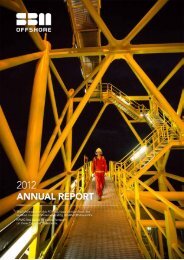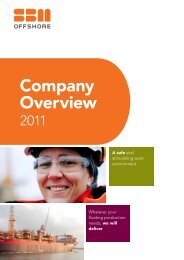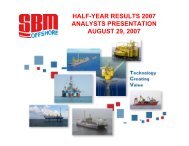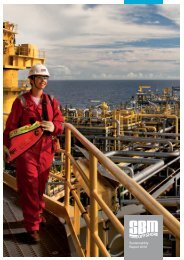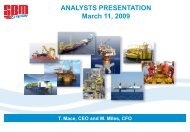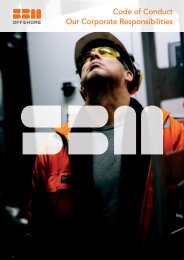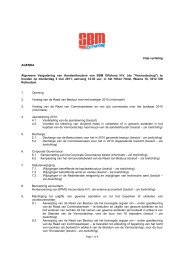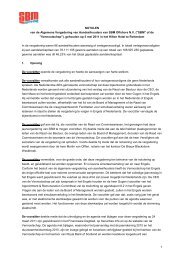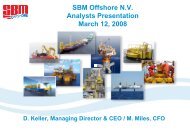Annual Report 2010 - SBM Offshore
Annual Report 2010 - SBM Offshore
Annual Report 2010 - SBM Offshore
You also want an ePaper? Increase the reach of your titles
YUMPU automatically turns print PDFs into web optimized ePapers that Google loves.
y a large buoyant structure when disconnected. The<br />
Company has therefore developed a specific product<br />
for this application, the MoorSpar, which now<br />
enables SCRs to be deployed with a disconnectable<br />
FPSO. The MoorSpar expands the opportunities for<br />
disconnectable FPSOs into ultra-deepwater or difficult<br />
reservoirs where SCRs are required.<br />
The Company continues to develop and increase the<br />
capacity of its proprietary swivel systems. Current<br />
work includes expanding the pressure and temperature<br />
range of our existing fluid swivels, and developing<br />
a new large-capacity High Voltage (HV) electrical<br />
swivel. For the HV swivel, qualification tests have been<br />
performed at 36 kV and up to 1500 Amps, enabling<br />
the Company to meet the increasing demands of the<br />
industry for HV power transfer systems.<br />
Gravity Actuated Pipe<br />
The Gravity Actuated Pipe (GAP) was developed<br />
several years ago and is now successfully in operation<br />
in the Kikeh field in Malaysia where it acts as a<br />
mid-water connection between the Company-owned<br />
FPSO Kikeh with a satellite floating dry tree wellhead<br />
unit. Further development of the GAP product continues<br />
with specific focus on increasing the operating<br />
envelope in terms of higher payload and longer distance<br />
between the two floating bodies.<br />
Steel Catenary Risers<br />
In ultra-deep water, riser systems comprise an increasingly<br />
significant part of the overall field development<br />
costs and have become more technically challenging.<br />
Traditional unbonded flexible riser solutions become<br />
increasingly heavy and expensive and are at the limit of<br />
their application range. Steel Catenary Risers (SCRs)<br />
offer advantages over unbonded flexible risers by being<br />
more cost effective while having a wider range of application<br />
in these ultra-deepwater conditions.<br />
A breakthrough in the use of SCRs was achieved in<br />
2009 with the first ever deployment on a turret moored<br />
FPSO. The Company successfully connected and commissioned<br />
a Lazy-Wave steel riser system (supplied<br />
by others) to the FPSO Espirito Santo, in Brazil. This<br />
innovation was recognised at the 2009 Deep <strong>Offshore</strong><br />
Technology International conference with the “Best<br />
<strong>Report</strong> of the Board of Management<br />
Technical Innovation” award. Operating in approximately<br />
1,800 metres water depth, this system is classified as an<br />
ultra-deepwater project. Further study work to expand<br />
the operational range of SCRs for use in harsher environments<br />
and at reduced water depths down to around<br />
1,000 metres was completed. This allows the Company to<br />
offer SCRs with FPSOs, TLPs and semi-submersibles for<br />
service conditions found in almost all deep to ultra-deep<br />
development areas.<br />
The traditional design of SCRs utilises welded pipe sections<br />
which require expensive S or J-lay installation<br />
vessels. The normal weld procedures used with these<br />
installation vessels precludes the use of some very<br />
high-grade steels, which would be very advantageous<br />
in greater depths with high-pressure and/or high-temperature<br />
wells. The Company has therefore developed a<br />
competitive alternative method for SCR fabrication and<br />
installation using fatigue-resistant threaded mechanical<br />
connectors. This allows much faster offshore jointing<br />
of the SCR sections and avoids the need for traditional<br />
field-welded joints. This method therefore allows and<br />
facilitates use of very high-grade steel pipe required for<br />
some ultra-deepwater wells, and also significantly reduces<br />
installation time offshore. The qualification programme<br />
for the Company’s connector was completed in 2009 in<br />
accordance with the ISO/DIS 21329 standard, making this<br />
connector now commercially available.<br />
LNG Production, Transfer and<br />
Storage Systems<br />
Acknowledging the growing importance of gas as a world<br />
energy source, the Company has maintained its focus on<br />
developing technologies and infrastructure associated<br />
with enabling offshore floating LNG-based projects. Such<br />
projects are now starting to be developed by several leading<br />
oil and gas operators and the required technology is<br />
rapidly maturing in a number of areas. The Company is<br />
currently working in the following areas for LNG projects:<br />
• the FLNG for offshore production of LNG;<br />
• cryogenic floating hose for LNG transfer;<br />
• offshore floating LNG storage, regasification and export<br />
to pipeline.<br />
The Company, together with its partners, remains at the<br />
forefront of these developments. <strong>SBM</strong> <strong>Offshore</strong> believes<br />
<strong>SBM</strong> <strong>Offshore</strong> – <strong>Annual</strong> <strong>Report</strong> <strong>2010</strong> 69




